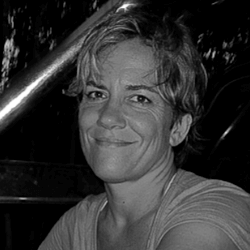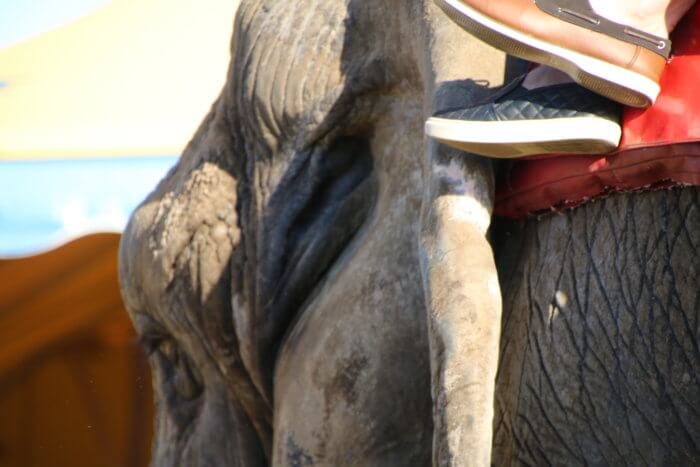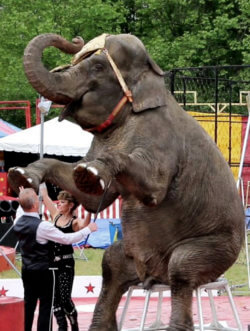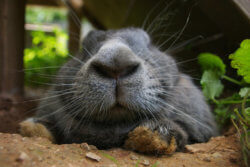
Since 2017, Gigi Glendinning—a captive animal photographer and collage artist whose work is dedicated to ending the use of nonhuman animals in entertainment—has supported our fight for freedom and sanctuary for Beulah, Karen, and Minnie by sharing her photos of the elephants with the NhRP and allowing us to share them with our supporters and the media. Her work is powerful and important because it shows the world the realities of the lives of these elephants as autonomous beings with no rights, laboring at circuses and fairs across the Northeast under the threat of a bullhook as the property of the Commerford Zoo. Gigi’s website The Graphic Rabbit is an excellent resource for anyone interested in examining the disconnect between our love for nonhuman animals and how we treat them. Ahead of an important hearing happening on Monday, April 22nd in Beulah, Karen, and Minnie’s case, I talked to Gigi about how and why photography became such a vital part of her animal advocacy work:

Thank you so much for documenting the suffering of our elephant clients and so many other nonhuman animals. We know it’s emotionally difficult work. How do you handle it?

It is difficult to witness their suffering and heartbreaking to leave the animals behind. However, when I arrive at a location, my adrenaline kicks in and I feel empowered by the opportunity to collect evidence. Moreover, when my images are useful for supporting important nonhuman animal cases like yours, I’m inspired to go out again. It was very emotional for me when I saw dear Minnie’s story circulating in China! Thank you for bringing so much attention to the Commerford elephants and all the animals exploited for entertainment.
When and how did your advocacy for animals begin, and how and why did photography become your focus?
I’ve always had an affinity for animals and a concern for those held captive, but my activism really elevated when I rescued 22 rabbits from a backyard breeder in 2007. My photos of the rabbits enjoying their newfound freedom created an opening for me to discuss the pet trade with people. Like the NhRP cases, introducing an animal by name, showing their face, and explaining their circumstance evokes empathy for that individual animal and connects people to the larger issue. So, I’d have to say, those precious bunnies taught me the power of my camera.

What do you think people mean when they say they “love” animals, and how would you say your work engages with this question? Do you see individual and/or collective appeals for justice and change as originating out of something we might call love for animals?
I believe people who say they love or care for animals genuinely do, but unfortunately, saying so does not necessarily equate to treating [all] animals well. The suffering I document takes place at venues and businesses that target “animal lovers” with misleading advertisements and mission statements: pet stores, zoos, aquariums, and circuses. I watch the very people who are drawn to animals perpetuate the abuse with their ticket purchase (or live animal sale), without thinking it through or doing the necessary due diligence to know better. To make matters worse, some people are well aware of the harm and participate anyway. My photographs document the toll these places have on the animals. I aim to challenge people on a moral level, so they align their actions and their dollars with their values.
I believe appeals for justice and change originate from a place of love, but they also come with knowledge, education and time. There is more than enough evidence to know that the nonhuman animals we are fighting for deserve the opportunity and liberty to experience their natural born lives. As a society, we should not tolerate their oppression; we know better and we need to do better.
You attended Hercules and Leo’s habeas corpus hearing in 2015. Thank you! What brought you to the courtroom that day, and how would you describe the experience?
Yes! I read about the case online and since I live only a short drive from NYC, I decided to go. I will never forget Judge Jaffe’s comment, “Isn’t it incumbent on the judiciary to at least consider whether a class of beings might be granted a right?” She followed that question with a remark about it being the courts’ very purpose to evolve our laws. It was a profound moment; I felt the animal rights movement surge forward. I knew I was witnessing history and I was excited to get behind and do more to support NhRP’s legal efforts.
What kind of changes would you most like to see this year? Five years? Twenty? How do you think the visual arts in particular can help us achieve them?
I would like to see more people calling their legislators in support of groundbreaking campaigns that offer permanent, legal protection for nonhuman animals. Based on my experiences lobbying to ban traveling wild animal acts, success is attained when a high number of constituents are actively involved. Legislators need to hear from us, they need to know nonhuman animals matter to the people they represent. If that can happen this year, for the next five years, and in twenty years, we’ll be in good shape!
Visual arts play a significant role in raising awareness about animals that need our help. From documentaries like Unlocking the Cage to single images depicting the reality on the ground, we must continue to circulate the facts in visually compelling ways that engage and empower people to care. As Jane Goodall so aptly noted, “Only if we understand, can we care. Only if we care, we will help. Only if we help, we shall be saved.”
Thank you Gigi!
Learn more about Gigi’s work and find links to her social media pages here. For details about the April 22nd hearing in Beulah, Karen, and Minnie’s elephant rights case, visit this page.